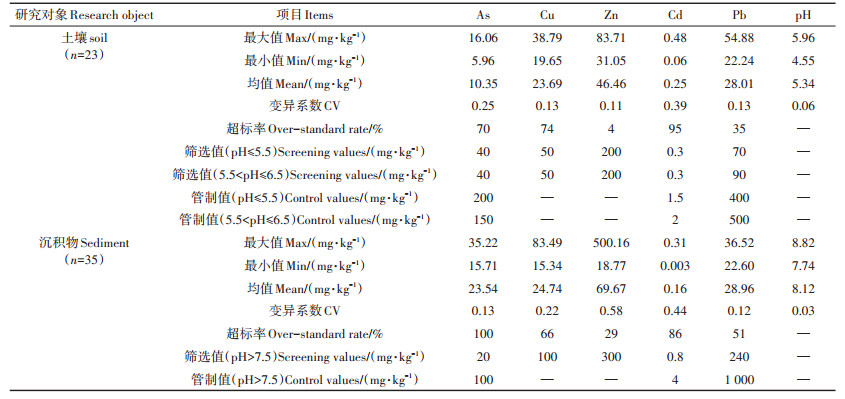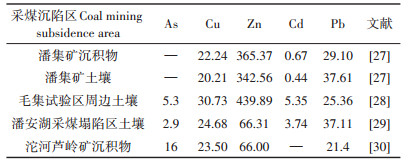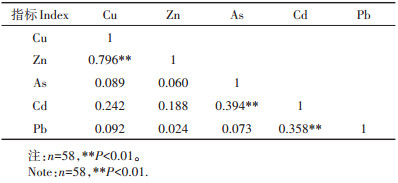2. 安徽省矿山生态修复工程实验室, 安徽 合肥 230601
2. Mine Ecological Restoration Engineering Laboratory, Anhui Province, Hefei 230601, China
我国是世界上煤炭资源最丰富的国家之一,在能源结构上,长期以煤炭作为主要能源[1]。采煤活动导致地表形态、气候、生物等生态因素发生变化,尤其是地面沉陷[2]。研究表明,每开采万吨原煤造成的沉陷地面积为0.20~0.33 hm2[3]。淮南是我国重要的煤炭基地,煤炭开采导致了大面积地下采空区的形成,因淮南地处高潜水位地区,所以地表沉陷的区域形成了大面积的积水,从而形成了采煤沉陷积水区[4]。
重金属是土壤和沉积物中常见的污染物,具有不可降解性、可累积性等特点[5],已引起巨大的环境问题[6-7]。煤及其附属物中含有多种重金属,在开采过程中这些重金属可通过一系列物理化学作用释放、迁移到地表环境介质中[8-9],并经过食物链不断累积,最终富集于人体,进而威胁人类的健康[10-11]。针对采煤沉陷区重金属问题,黄肖萌等[12]研究了淮南谢桥矿采煤沉陷区土壤中Cd、Hg、Cr、Ni、Cu、Pb、Zn、Fe 8种元素的污染程度,其中Zn、Cd的污染程度最为突出;苏桂荣[13]指出,淮南谢桥矿采煤沉陷区底泥重金属竖向分布规律有两种类型,第一类是直线型,第二类是表层和底层重金属含量低于中间层;王丹等[14]研究了谢桥煤矿采煤沉陷区沉积物中7种重金属的污染程度,发现Cd的污染程度最大。虽然对谢桥采煤沉陷区土壤和沉积物重金属问题已有相关研究,但对土壤和沉积物中重金属的空间分布规律以及影响因素缺乏更深一步的了解。因此,本文以谢桥矿附近的迪沟采煤沉陷区为研究对象,重点关注土壤和沉积物中Cu、Zn、Pb、Cd、As 5种典型重金属元素含量以及空间分布特征,同时采用地累积指数和潜在生态风险指数进行评价,分析5种重金属元素的污染水平,进而为迪沟采煤沉陷区重金属污染防治提供科学依据。
1 材料与方法 1.1 研究区概况迪沟采煤沉陷区(32°45′ 57″ ~32°48′ 42″ N,116° 19′31″~116°26′38″E)位于安徽省颍上县迪沟镇,北靠南淝河,南临济河,主要由农田塌陷而成。研究区域属暖温带半湿润季风气候,年均气温14.5~17.0 ℃,1月平均温度为1.0~1.2 ℃,7月为28.0 ℃,年日照2 183.7~2 425.3 h,无霜期约为211 d。年均相对湿度80%,平均降水量950 mm左右。迪沟采煤沉陷区水域存在明显的不同,西部水域有生活污水纳入,中部水域周边有煤矸石堆,堆积面积为13.33 hm2,其水域底部由煤矸石填充,东部水域有养殖废水纳入。土壤类型主要是砂浆黑土,研究区以农业为主,工业不发达。
1.2 样点设置与样品采集及预处理迪沟采煤沉陷区土壤和沉积物样品采集于2018年10月,采集表层0~20 cm的土壤约1 kg,采样时除去地表凋落物,每个采样点均取3个平行样品,并将其混匀。将采集的样品于室内阴凉处风干,剔除石块和碎屑,用玛瑙研钵研磨并过0.149 mm尼龙筛后装密封袋备用[15]。沉积物样品采用面积为1/16 m2的改良彼得森采泥器采集,将采集的样品于实验室真空冷冻干燥后研磨过筛保存[16]。研究区共设置23个土壤采样点和35个沉积物采样点(图 1)。
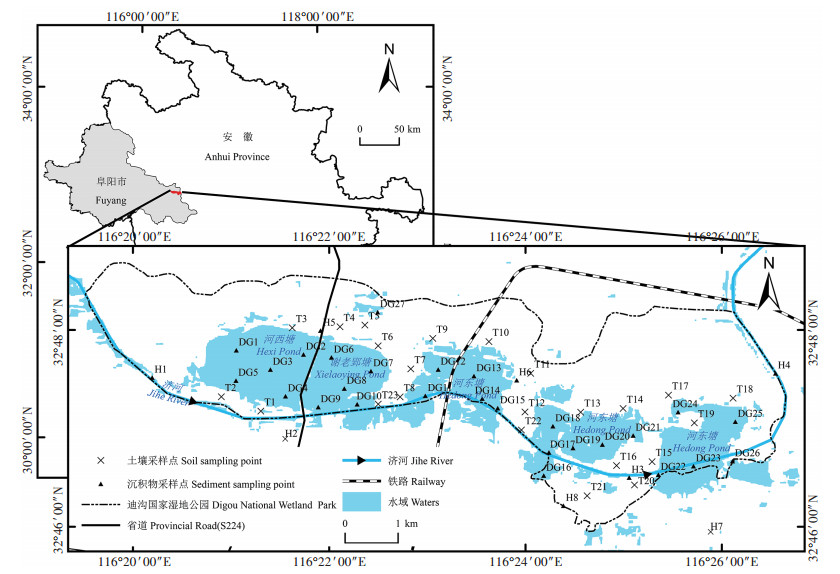
|
深陷水域:DG1~DG27;河流:H1~H8;土壤:T1~T23 Subsidence water area: DG1~DG27; River: H1~H8; Soil: T1~T23 图 1 研究区土壤和沉积物采样点示意图 Figure 1 Schematic diagram of the soil and sediment sampling points in the study area |
土壤和沉积物pH采用pH计(pHS-3C)测定(土m∶水V=1 g∶5 mL)[17];样品使用HCl-HNO3-HF-HClO4电热板240 ℃消解[18],再稀释10倍后采用电感耦合等离子体质谱仪[19](ICAPQ,Thermo Fisher,美国)测定Zn、As、Cd、Pb、Cu的含量。样品分析过程中,采用国家土壤和沉积物标准物质(GSS-5a和GSS-26)进行质量控制,标准物的回收率在91%~105% 之间,符合分析质量控制标准。
1.4 评价方法 1.4.1 地累积指数评价地累积指数计算公式[20]如下:

|
式中:Ci为重金属i的实测值,mg·kg-1;Bi为重金属i的土壤元素背景值[21],Cu 21.55 mg·kg-1,Zn 76.88 mg·kg-1,Cd 0.093 mg·kg-1,Pb 28.03 mg·kg-1,As 8.21 mg·kg-1。
1.4.2 潜在生态风险指数Hakanson提出的潜在生态风险指数的计算公式如下[22]:

|
式中:RI为综合潜在风险指数;Eri为重金属i的单项潜在风险系数;Tri为污染物的毒性响应参数[23],Cu和Pb为5,Zn为1,Cd为30,As为10;m为污染物的种类;Cfi为污染物i的污染参数;Cni为重金属i的参比值。潜在生态风险评价标准如表 1所示[24]。
|
|
表 1 潜在生态风险程度评价指标 Table 1 Evaluation index of potential ecological risk degree |
用Excel 2016和SPSS 21.0对数据进行描述性和相关性统计分析;以不同金属元素含量和评价结果作为变量,对其进行反距离权重插值,再经ArcGIS 10.3进行制图[25]。
2 结果与讨论 2.1 土壤和沉积物中的重金属含量如表 2所示,迪沟采煤沉陷区土壤中Cd、As、Cu的含量均值分别是砂浆黑土背景值的2.69、1.26、1.10倍,超标率分别为95%、70%、74%。沉积物中Cu、As、Cd、Pb的含量均值分别是背景值的1.15、2.87、1.72、1.03倍,超标率分别为66%、100%、86%、51%。将沉积物和土壤相比较,其中Cu和Pb含量相差较小,但沉积物中的As、Zn含量明显更高,土壤中Cd含量更高,整体表现为水域高于陆域的特点。
|
|
表 2 研究区土壤和沉积物重金属含量统计 Table 2 Heavy metal element content of soil and sediment in the study area |
参考《土壤环境质量农用地土壤污染风险管控标准(试行)》(GB 15618—2018),土壤污染风险筛选值和管制值统一采用5.5 < pH≤6.5和pH < 5.5较严格的值,新标准未设置Zn、Cu的管制值,全部样本的Cu和As含量均低于筛选值,21.7% 的样本Cd含量高于筛选值,但尚低于管制值;沉积物的筛选值和管制值采用pH > 7.5的值,其中80% 的样本As含量高于筛选值,但未超过管制值。因此,研究区内的土壤中Cd超标率为21.7%,沉积物中As超标率为80%。
变异系数(CV)可反映各样本的平均变异程度,有研究认为[26]CV < 0.15为弱变异,CV > 0.36为强变异。由表 2可见,土壤中Cd的变异系数超过0.36,表现为强变异,As表现为中等变异;沉积物中Zn和Cd的变异系数均大于0.36,表现为强变异,Cu呈现中等变异性。说明研究区重金属元素含量分布不均匀,其中Zn和Cd最为显著,受到外界因素影响较大。
表 3列出了国内相关采煤沉陷区研究中的土壤和沉积物重金属含量。与其他采煤沉陷区相比,迪沟采煤沉陷区土壤和沉积物中As含量是其他地区的2~8.1倍,Zn、Cd、Pb含量相对较低,Cu含量和其他沉陷区相差较小,说明迪沟采煤沉陷区As的污染问题不容忽视。初步推测与当地塌陷水域底部存在煤矸石填埋以及周边农用土壤农药化肥的使用有关[31-32]。
|
|
表 3 其他沉陷区重金属含量(mg·kg-1) Table 3 Heavy metal content in other subsidence areas(mg·kg-1) |
迪沟采煤沉陷区中Cu、Pb、Zn、Cd、As的含量具有显著差异(P < 0.05),利用反距离权重插值法得到研究区5种重金属含量的空间分布特征见图 2。由图 2可知,Cu、Zn含量具有相似的空间分布规律,在土壤中分布均匀;沉积物中,入区河流H4中Zn含量最高,水域DG26中Cu含量最高。虽然在DG26采样点Zn未呈现出较高值,但也达到了70 mg·kg-1,表明该采样点依然残留并富集一定程度的Zn。从入区河流向内,重金属含量渐低,形成以入区河流含量最高,整体分布均匀的局势。H4以及DG26采样点周边村庄密集,由于地方长期养殖家禽等,排出的养殖废水使得沉积物及其周边土壤中Cu、Zn含量不同程度增加。猪场以及禽畜养殖废水能够增加土壤中的Zn、Cu含量也被其他研究所证实[33-34]。
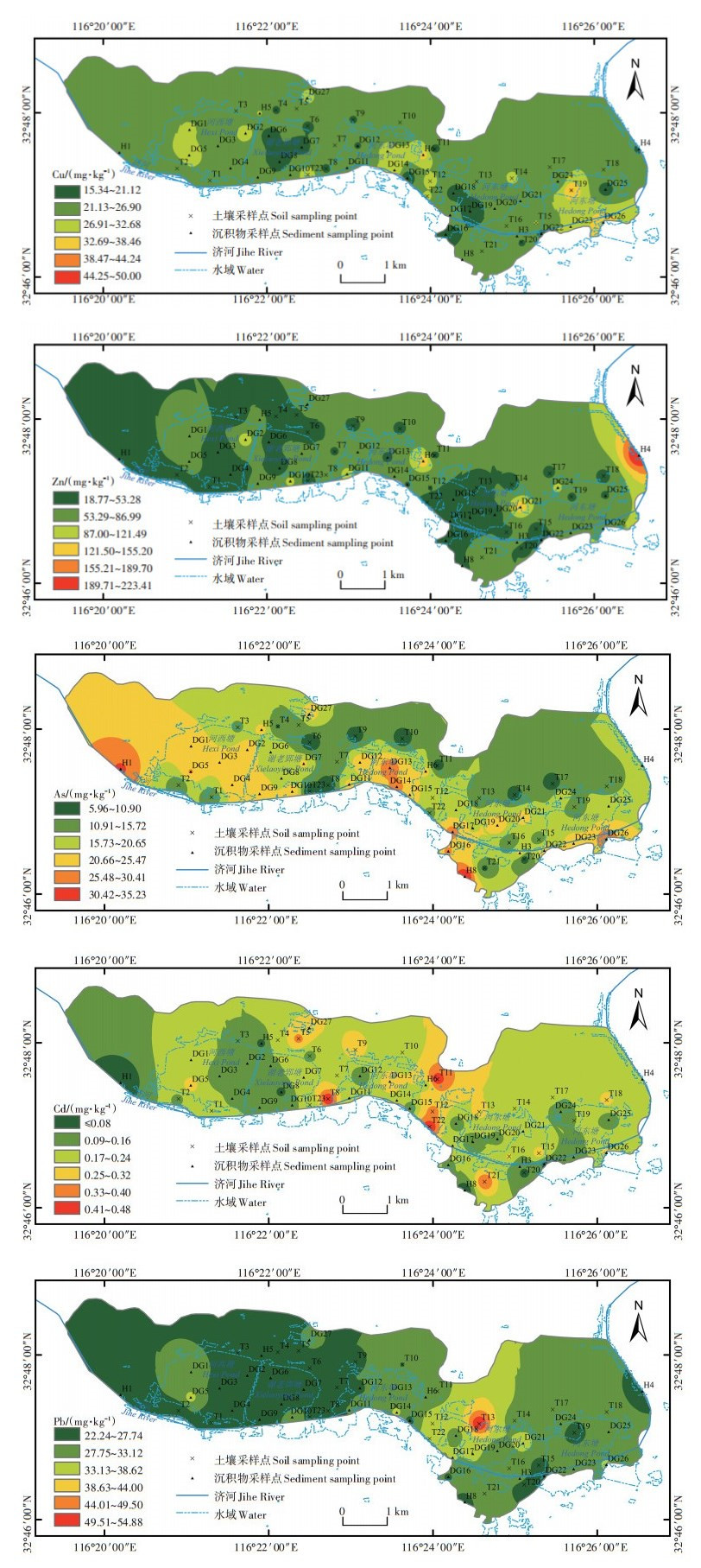
|
图 2 迪沟采煤沉陷区土壤和沉积物重金属空间分布 Figure 2 Spatial distribution of heavy metals in soil and sediments in the Digou coal mining subsidence area |
As在沉积物中含量较高,高值区主要位于H1、H8、DG13、DG14、DG16、DG17采样点。总体上看(图 2),研究区中部及西部较高,东部较低。已有研究证明煤矸石的堆积会使As明显富集,造成As环境污染[31]。此外,入区河流H1、H8有城镇生活污水纳入,从而导致上述采样点As含量不同程度的增加。生活污水能够增加土壤中As的含量已被其他研究所证实[35]。
土壤中的Cd在T8、T11、T21、T22采样点呈现出较高值,沉积物的高值区主要分布于研究区中部。总体上看(图 2),Cd的分布表现为中部较高,东西两侧较低的趋势,其原因是土壤和沉积物中的Cd受到煤矸石堆积以及农业化肥使用等多方面因素影响[31, 36]。一方面,T8、T11、T21、T22采样点为农用土壤,农田的施肥在某种程度上会使得Cd含量增多;另一方面,研究区中部水域底部存在煤矸石堆积,从而使得Cd含量增多。
由图 2可知,Pb含量在T13采样点呈现出较高值,总体上呈现中部高于东西部的特点。T13采样点周边交通网相对于其他采样点更加发达,长期车辆通行产生大量汽车尾气,富含Pb的尾气颗粒沉降在土壤中,使得土壤中Pb含量增多。同样也有学者的研究结果与此相似,结果表明汽车含Pb汽油的燃烧是大气中Pb含量超标的主要原因[37]。
2.3 重金属环境质量评价 2.3.1 地累积指数污染评价如表 4所示,在沉积物35个采样点中,As的Igeo值在0~2之间,以轻度污染为主,占63.6%;Cd、Zn和Cu的Igeo≤1,其中Cd以轻度污染为主,占51.5%,而Cu和Zn则以未污染为主,分别占90.9% 和93.9%;Pb的Igeo < 0,表明Pb未达到污染等级。迪沟采煤沉陷区沉积物中5种重金属Igeo均值依次为As > Cd > Cu > Pb > Zn,其中,As的污染等级最高,其Igeo均值为0.88。在土壤23个采样点中,Cd的Igeo < 2,以轻度污染为主,占60.9%;As和Pb的Igeo小于0,都以未污染为主,分别占69.6%和95.7%;Zn和Cu的Igeo < 0,全部为未污染等级。其中,Cd的Igeo均值达到0.71,所受到的污染程度相对较高。这表明,迪沟采煤沉陷区土壤和沉积物在一定程度上受到重金属污染,其中As和Cd最为显著,整体污染等级表现为未污染到轻度污染。
|
|
表 4 研究区土壤与沉积物重金属地累积指数 Table 4 Geological accumulation index of heavy metals in soil and sediment in the study area |
土壤重金属污染可直接威胁食品安全[38],而沉积物重金属污染的潜在危害主要是活化释放后的二次污染[39],因此评价重金属污染土壤和沉积物的潜在生态危害至关重要。由表 5计算结果可得,土壤和沉积物中5种重金属按Eri平均值从大到小依次为Cd、As、Cu、Pb、Zn,其中Cd和As的生态风险最高。在采集的58个样本中,As、Cu、Pb、Zn的Eri均小于40,整体上表现为轻微生态危害。土壤和沉积物中Cd的Eri平均值为81.59和48.07,大部分处在中等风险水平以上。其中,土壤中Cd和As对RI的贡献率分别为77.3% 和11.9%,沉积物中Cd和As对RI的贡献率分别为54.2% 和32.6%,可以看出Cd和As是RI的主要贡献元素,总贡献率达到89.2% 和86.9%。从多元素角度综合分析,土壤潜在生态危害为轻微和中等,占比分别为82.6%和17.4%,整体上表现为轻微生态危害;沉积物潜在生态危害属于轻微级别的占100%,整体上表现为轻微生态危害。
|
|
表 5 研究区重金属潜在生态危害系数及潜在生态危害指数 Table 5 Eri and RI of heavy metals in the study area |
由图 3可知,综合潜在生态危害最强的是研究区中部土壤。总体来看,迪沟采煤沉陷区表现为轻微生态危害。
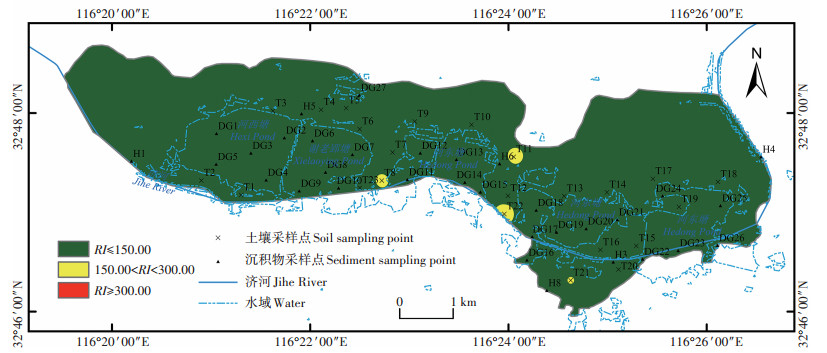
|
图 3 研究区综合潜在生态风险程度分布 Figure 3 Distribution of comprehensive potential ecological risk in the study area |
地累积指数法和潜在生态危害指数法的评价结果较为一致,两种评价方法均认为Cd和As是研究区土壤和沉积物的主要污染物,在实际应用中,将多种评价方法结合能更准确地反映研究区域的污染情况[15]。
2.4 重金属相关性分析重金属之间相关性可以表明其是否具有同源性,相关性高的重金属之间可能具有同源性;相关性低的重金属之间可能具有多种来源[40]。由表 6可知,Cu-Zn、As-Cd和Cd-Pb间在0.01水平上显著相关,其中Cd和As是主要污染物,可见Cd与As的富集现象具有同源性。
|
|
表 6 土壤和沉积物中重金属间相关性 Table 6 Correlation between heavy metals in soil and sediment |
研究区域中工业区较少,重金属来源于重工业的可能性较小。有研究表明,生活污水的灌溉会造成土壤中Cd和As的富集[35];煤矸石堆积会对As和Cd造成明显的影响[31];农业施用的磷肥等均混杂有As、Cd等重金属[41]。结合重金属空间分布图及污染评价结果,土壤和沉积物中Cd和As的积累很可能源于化肥农药的使用、城镇生活废水的排放以及煤矸石堆积等人为因素。故应通过合理施用化肥、控制废水排放以及减少煤矸石的堆积等措施控制区域内重金属污染。
3 结论(1)迪沟采煤沉陷区土壤的As、Cu、Cd含量均高于背景值,沉积物的As、Cu、Cd、Pb含量高于背景值。将沉积物和土壤与质量标准相比较,沉积物中As的污染风险最高,土壤中的Cd污染风险最高,重金属污染程度依次为Cd > As > Cu > Pb > Zn。
(2)水域沉积物重金属含量普遍高于陆域土壤。从入区河流向内,沉积物重金属含量逐渐降低。土壤中,总体上以中部区域含量最高。
(3)研究区土壤和沉积物重金属地累积指数显示As和Cd的污染相对较重,整体表现为未污染-轻度污染,潜在生态风险指数评价结果为轻微生态危害,As和Cd是潜在生态风险的主要贡献元素。
| [1] |
王佟, 孙杰, 江涛, 等. 煤炭生态地质勘查基本构架与科学问题[J]. 煤炭学报, 2020, 45(1): 276-284. WANG Tong, SUN Jie, JIANG Tao, et al. Basic configuration and scientific problems of coal eco-geological survey[J]. Journal of China Coal Society, 2020, 45(1): 276-284. |
| [2] |
Chen G Z, Wang X M. Health risk assessment of potentially harmful elements in subsidence water bodies using a Monte Carlo approach: An example from the Huainan coal mining area, China[J]. Ecotoxicology and Environmental Safety, 2019, 171: 737-745. DOI:10.1016/j.ecoenv.2018.12.101 |
| [3] |
李新举, 胡振琪, 李晶, 等. 采煤塌陷地复垦土壤质量研究进展[J]. 农业工程学报, 2007, 23(6): 276-280. LI Xin-ju, HU Zhen-qi, LI Jing, et al. Research progress of reclaimed soil quality in mining subsidence area[J]. Transactions of the Chinese Society of Agricultural Engineering, 2007, 23(6): 276-280. DOI:10.3321/j.issn:1002-6819.2007.06.056 |
| [4] |
Robert L T, Jonathan P M. Reviews of science for science librarians: Coal science and technology research 1970—2010[J]. Taylor & Francis Group, 2012, 31(2): 146-163. |
| [5] |
Richard O, Samuel A O, Robert L G, et al. Potential risk effect from elevated levels of soil heavy metals on human health in the Niger delta[J]. Ecotoxicology and Environmental Safety, 2012, 85: 120-130. DOI:10.1016/j.ecoenv.2012.08.004 |
| [6] |
唐鸿达, 高良敏. 淮南矿区塌陷水域沉积物营养物质和重金属现状调查与评价[J]. 绿色科技, 2013(8): 183-185, 189. TANG Hong-da, GAO Liang-min. Status survey and evaluation of nutrients and heavy metals in sediments in subsidence area of Yangzhuan of Huainan mining area[J]. Journal of Green Science and Technology, 2013(8): 183-185, 189. DOI:10.3969/j.issn.1674-9944.2013.08.083 |
| [7] |
蔡峰, 刘泽功, 林柏泉, 等. 淮南矿区煤矸石中微量元素的研究[J]. 煤炭学报, 2008, 33(8): 892-897. CAI Feng, LIU Ze-gong, LIN Bo-quan, et al. Study on trace elements in gangue in Huainan mining area[J]. Journal of China Coal Society, 2008, 33(8): 892-897. DOI:10.3321/j.issn:0253-9993.2008.08.011 |
| [8] |
刘慧力, 崔龙鹏. 淮南矿区水体沉积物中金属污染及环境现状评价[J]. 环境科学研究, 2009, 22(5): 601-606. LIU Hui-li, CUI Long-peng. Assessment of pollution and environmental status of metals in sediments of subsidence-land-water -ponds in Huainan mining area[J]. Research of Environmental Sciences, 2009, 22(5): 601-606. |
| [9] |
Ouyang W, Wang Y D, Lin C Y, et al. Heavy metal loss from agricultural watershed to aquatic system: A scientometrics review[J]. Science of the Total Environment, 2018, 637/638: 208-220. DOI:10.1016/j.scitotenv.2018.04.434 |
| [10] |
Dipark P. Research on heavy metal pollution of river Ganga: A review[J]. Annals of Agrarian Science, 2017, 15(2): 278-286. DOI:10.1016/j.aasci.2017.04.001 |
| [11] |
Wei J F, Wu D Q, Peng J L, et al. Release and kinetics of heavy metals from the contaminated sediments[J]. Ecology and Environment, 2003, 12(2): 127-130. |
| [12] |
黄肖萌, 刘诗敏, 杨茗, 等. 淮南谢桥塌陷区表层土壤重金属污染分布特征与现状评价研究[J]. 山东工业技术, 2017(2): 133-134. HUANG Xiao-meng, LIU Shi-min, YANG Ming, et al. Study on the distribution characteristics and status quo of heavy metal pollution in the surface soil of Xieqiao subsidence area in Huainan[J]. Shandong Industrial Technology, 2017(2): 133-134. |
| [13] |
苏桂荣. 淮南潘谢矿区底泥与土壤中重金属竖向分布规律研究[D]. 淮南: 安徽理工大学, 2012: 26-80. SU Gui-rong. The research of vertical distribution of heavy metal in sediment and soil of Panji and Xieqiao mining areas, Huainan City[D]. Huainan: Anhui University of Science and Technology, 2012: 26-80. |
| [14] |
王丹, 高良敏. 淮南沉陷水区沉积物重金属污染评价的研究[J]. 绿色科技, 2014(5): 217-218, 220. WANG Dan, GAO Liang-min. Research on heavy metal pollution assessment of sediments in Huainan subsidence water area[J]. Journal of Green Science and Technology, 2014(5): 217-218, 220. DOI:10.3969/j.issn.1674-9944.2014.05.096 |
| [15] |
韦绪好, 孙庆业, 程建华, 等. 焦岗湖流域农田土壤重金属污染及潜在生态风险评价[J]. 农业环境科学学报, 2015, 34(12): 2304-2311. WEI Xu-hao, SUN Qing-ye, CHENG Jian-hua, et al. Pollution and potential ecological risk assessment of heavy metals in farmland soils in Jiaogang Lake basin, China[J]. Journal of Agro-Environment Science, 2015, 34(12): 2304-2311. DOI:10.11654/jaes.2015.12.008 |
| [16] |
陈飘雪, 王变, 孙庆业. 焦岗湖及入湖河流表层沉积物重金属潜在生态风险评价[J]. 湿地科学, 2016, 14(1): 37-43. CHEN Piao-xue, WANG Bian, SUN Qing-ye. Potential ecological risk assessment of heavy metals in surface sediments of Jiaogang Lake and its inflow rivers[J]. Wetland Science, 2016, 14(1): 37-43. |
| [17] |
Shen Z J, Xu D C, Li L L, et al. Ecological and health risks of heavy metal on farmland soils of mining areas around Tongling City, Anhui, China[J]. Environmental Science and Pollution Research, 2019, 26(15): 15698. DOI:10.1007/s11356-019-04463-0 |
| [18] |
陈玉东, 王火焰, 周健民, 等. 黑龙江省海伦市农田土壤重金属分布特征及污染评价[J]. 土壤, 2012, 44(4): 613-620. CHEN Yu-dong, WANG Huo-yan, ZHOU Jian-min, et al. Heavy metals distribution characteristics and pollution assessment in farmland soils of Hailun City, Heilongjiang Province[J]. Soils, 2012, 44(4): 613-620. |
| [19] |
鲁如坤. 土壤农业化学分析方法[M]. 北京: 中国农业科技出版社, 2000. LU Ru-kun. Analytical methods for soil agricultural chemistry[M]. Beijing: China Agricultural Science and Technology Press, 2000. |
| [20] |
Muller G. Index of geoaccumulation in sediments of Rhine River[J]. Geojournal, 1969, 22(3): 2520-2530. |
| [21] |
中国环境监测总站. 中国土壤元素背景值[M]. 北京: 中国环境科学出版社, 1990: 329-368. China National Environmental Monitoring Centre. China' s soil element background values[M]. Beijing: China Environmental Science Press, 1990: 329-368. |
| [22] |
Hakanason L. An ecological risk index for aquatic pollution control: A sedimentological approach[J]. Water Research, 1980, 14(8): 975-1001. DOI:10.1016/0043-1354(80)90143-8 |
| [23] |
徐争启, 倪师军, 庹先国, 等. 潜在生态危害指数法评价中重金属毒性系数计算[J]. 环境科学与技术, 2008, 31(2): 112-115. XU Zheng-qi, NI Shi-jun, TUO Xian-guo, et al. Calculation of heavy Metals' toxicity coefficient in the evaluation of potential ecological risk index[J]. Environmental Science & Technology, 2008, 31(2): 112-115. DOI:10.3969/j.issn.1003-6504.2008.02.030 |
| [24] |
Jasinski S M. The materials flow of mercury in the United States[J]. Resources, Conservation and Recycling, 1995, 15(3): 145-179. |
| [25] |
阳文锐, 王如松, 黄锦楼, 等. 反距离加权插值法在污染场地评价中的应用[J]. 应用生态学报, 2007, 18(9): 2013-2018. YANG Wen-rui, WANG Ru-song, HUANG Jin-lou, et al. Application of inverse distance weighted interpolation method in contaminated site assessment[J]. Chinese Journal of Applied Ecology, 2007, 18(9): 2013-2018. |
| [26] |
马群, 赵庚星. 集约农区不同土地利用方式对土壤养分状况的影响[J]. 自然资源学报, 2010, 25(11): 1834-1843. MA Qun, ZHAO Geng-xing. Effects of different land use types on soil nutrients in intensive agricultural region[J]. Journal of Natural Resources, 2010, 25(11): 1834-1843. DOI:10.11849/zrzyxb.2010.11.003 |
| [27] |
雒建伟, 高良敏, 陈一佳, 等. 潘一采煤塌陷区底泥重金属分布特征[J]. 广州化工, 2017, 45(2): 115-116, 127. LUO Jian-wei, GAO Liang-min, CHEN Yi-jia, et al. Distribution characteristics of heavy metals in sediments of Panji No. 1 coal mining subsidence[J]. Guangzhou Chemical Industry, 2017, 45(2): 115-116, 127. DOI:10.3969/j.issn.1001-9677.2017.02.038 |
| [28] |
王德高, 李江涛, 梁文勖. 采煤塌陷区周边土壤典型重金属元素调查与评价[J]. 煤炭科学技术, 2019, 47(2): 194-202. WANG De-gao, LI Jiang-tao, LIANG Wen-xu. Investigation and evaluation of typical heavy metal elements in soil around mining subsidence area[J]. Coal Science and Technology, 2019, 47(2): 194-202. |
| [29] |
杨瑞卿, 肖扬, 申晨. 采煤塌陷区土壤重金属污染及植物吸收富集特征[J]. 江苏农业科学, 2018, 46(20): 291-294. YANG Rui-qing, XIAO Yang, SHEN Chen. Heavy metal pollution and plant absorption and enrichment characteristics in coal mining subsidence area[J]. Jiangsu Agricultural Sciences, 2018, 46(20): 291-294. |
| [30] |
李致春, 桂和荣, 孙林华, 等. 沱河芦岭矿塌陷区段沉积物重金属污染及迁移能力评价[J]. 环境科学与技术, 2013, 36(7): 13-17, 22. LI Zhi-chun, GUI He-rong, SUN Lin-hua, et al. Pollution and migration ability assessment of heavy metals in sediments from Luling mine subsidence area section of Tuohe River[J]. Environmental Science & Technology, 2013, 36(7): 13-17, 22. DOI:10.3969/j.issn.1003-6504.2013.07.003 |
| [31] |
郝威铎. 煤矸石堆放对土壤、水体和植物的环境影响——案例研究[D]. 徐州: 中国矿业大学, 2015: 24-25. HAO Wei-duo. Environmental impacts of coal mine wastes stacking on the soil, waterbody and vegetation: Cases study[D]. Xuzhou: China University of Mining and Technology, 2015: 27-28. |
| [32] |
谢国雄, 王京文, 张丹, 等. 商品有机肥对作物产量及土壤与农产品中重金属积累的影响[J]. 中国农学通报, 2016, 32(29): 97-104. XIE Guo-xiong, WANG Jing-wen, ZHANG Dan, et al. Effects of commercial organic fertilizer application on crop yield and heavy metals accumulation in soil and agricultural products[J]. Chinese Agricultural Science Bulletin, 2016, 32(29): 97-104. DOI:10.11924/j.issn.1000-6850.casb16020034 |
| [33] |
李晓光. 猪场废水灌溉农田对土壤重金属Zn, Cu, As含量的影响[D]. 北京: 中国农业科学院, 2009: 16-24. LI Xiao-guang. The effect of irrigation with swine wastewater on heavy metals(Zn, Cu, As) in soil[D]. Beijing: Chinese Academy of Agricultural Sciences, 2009: 16-24. |
| [34] |
戴婷, 章明奎. 长期畜禽养殖污水灌溉对土壤养分和重金属积累的影响[J]. 灌溉排水学报, 2010, 29(1): 36-39. DAI Ting, ZHANG Ming-kui. Effects of long-term irrigation of livestock farm wastewater on nutrients and heavy metals in agricultural soils[J]. Journal of Irrigation and Drainage, 2010, 29(1): 36-39. |
| [35] |
姜勇, 梁文举, 张玉革, 等. 污灌对土壤重金属环境容量及水稻生长的影响研究[J]. 中国生态农业学报, 2004, 12(3): 129-132. JIANG Yong, LIANG Wen-ju, ZHANG Yu-ge, et al. Influence of wastewater irrigation on environmental capacity of soil heavy metals and rice growth[J]. Chinese Journal of Eco-Agriculture, 2004, 12(3): 129-132. |
| [36] |
王美, 李书田. 肥料重金属含量状况及施肥对土壤和作物重金属富集的影响[J]. 植物营养与肥料学报, 2014, 20(2): 466-480. WANG Mei, LI Shu-tian. Heavy metals in fertilizers and effect of the fertilization on heavy metal accumulation in soils and crops[J]. Journal of Plant Nutrition and Fertilizer, 2014, 20(2): 466-480. |
| [37] |
王桢, 张建强, 渡边泉, 等. 铁路和道路沿线土壤重金属含量及来源解析[J]. 生态环境学报, 2018, 27(2): 364-372. WANG Zhen, ZHANG Jian-qiang, DUBIAN Quan, et al. Concentrations and sources of heavy metals in soil near railway and road[J]. Ecology and Environmental Sciences, 2018, 27(2): 364-372. |
| [38] |
Li Q S, Cai S S, Mo C H, et al. Toxic effects of heavy metals and their accumulation in vegetables grown in a saline soil[J]. Ecotoxicology and Environmental Safety, 2010, 73(1): 84-88. DOI:10.1016/j.ecoenv.2009.09.002 |
| [39] |
陈宗团, 徐立, 洪华生. 河口沉积物-水界面重金属生物地球化学研究进展[J]. 地球科学进展, 1997, 12(5): 37-42. CHEN Zong-tuan, XU Li, HONG Hua-sheng. Biogeochemical processes of heavy metals at the sediment-water interface of estuary: A review[J]. Advances in Erath Science, 1997, 12(5): 37-42. |
| [40] |
胡明. 大荔县农田土壤重金属分布特征与污染评价[J]. 干旱区资源与环境, 2014, 28(1): 79-84. HU Ming. Distribution characteristics and pollution assessment for the farmland soil heavy metals in Dali county[J]. Journal of Arid Land Resources and Environment, 2014, 28(1): 79-84. DOI:10.3969/j.issn.1003-7578.2014.01.014 |
| [41] |
Harald G Z, Alarich R, Andrea H L. Biomonitoring of atmospheric heavy metal deposition by mosses in the vicinity of industral sites[J]. Journal of Atmospheric Chemistry, 2004, 49(1/2/3): 461-477. DOI:10.1007/s10874-004-1260-5 |
 2021, Vol. 40
2021, Vol. 40




